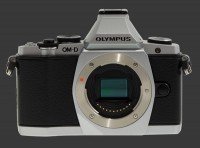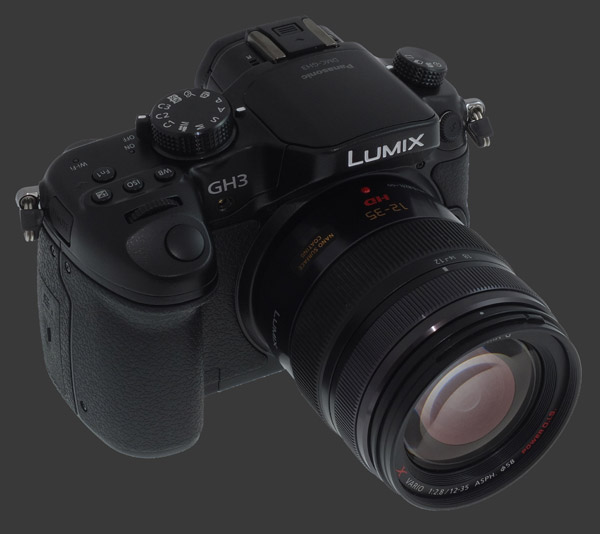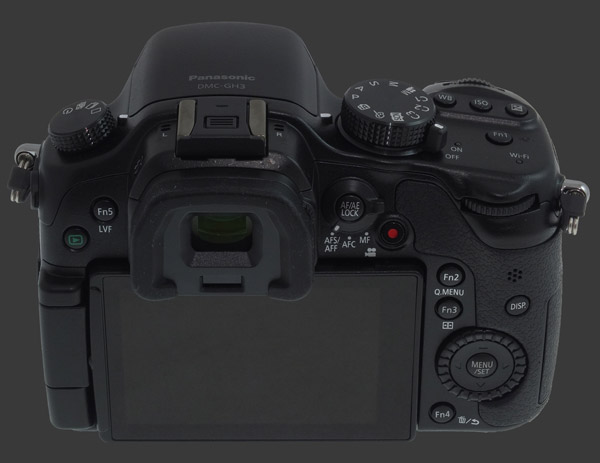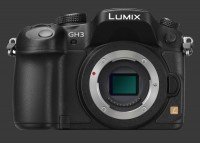Panasonic Lumix DMC-GH3 Review
Panasonic Lumix DMC-GH3 Introduction
The Panasonic Lumix DMC-GH3 is the current flagship Micro Four-Thirds Panasonic mirrorless. This digital camera is built around a 16 megapixels Four-Thirds sensor with an maximum ISO of 25600, 6 FPS full-resolution output and full 1080p HD video capability. The GH3 is built DSLR-style with a good hand-grip and a viewfinder hump covering a large high-resolution EVF.
Video capabilities are central to the GH3 to create a camera which tries to deliver both outstanding images and video. Video is available in multiple resolutions, frames rates and codecs. There is a built-in stereo microphone, an audio-level monitor, a mini-jack to use an external stereo input and headset connectorNew to the GH3 vs GH2. to hear audio being recorded.
This SLD provides a large number of buttons and dials to control its main features with minimum interaction through the menu system. Its EVF lets most settings be changed at eye-level. Triple control-dials, a mode-dial, a number of modal controls and the first weather-sealed mirrorless from Panasonic show that the GH3 is aimed at advanced photographers.
This in-depth digital camera review analyses the features, ergonomics, usability, performance and image quality of the Panasonic Lumix DMC-GH3.
Panasonic Lumix DMC-GH3 Features
Sensor
- 16 Megapixels CMOS Four-Thirds sensor
- Micro Four-Thirds lens mount
- Built-in ultra-sonic dust-reduction
Exposure
- Standard ISO 200 - 12800 range
- Expanded ISO 125 and 25600 available
- Auto ISO, customizable limit from 400 to 12800
- 1/4000-60s Shutter-speeds, Bulb up to 120s
- Electronic or Mechanical shutter
- PASM Exposure modes, with Program-Shift
- Multi-Segment, Center-Weighed and Spot metering
- Auto-Exposure Bracketing, 3, 5 or 7 frames, 1/3, 2/3 or 1 EV increments, ordered or unordered
- Exposure-Compensation, ±5, 1/3 increments
- Flash-Compensation, ±3, 1/3 increments
- TTL, ManualAdjustable between 1 and 1/128 power. or Wireless flash control
- Off, Forced, Redeye, Slow-Sync and Slow-Sync with Redeye flash modes
- Front or rear flash-sync
- Optional flash redeye removal
Image Parameters
- Automatic, 5 presetsSunny, Cloudy, Shade, Tungsten, Flash, kelvin and 4 custom white-balance settings
- White-balance fine-tuning along 2 axis in 19 steps
- White-balance bracketing, 3 frames, 3 step sizes
- 5 Color and 1 B&W Photo Styles modes
- Adjustable contrast, sharpness, saturation and noise-reduction, 11 steps each
- sRGB or Adobe RGB color space
- Optional Long-Shutter Noise-Reduction
Drive
- Continuous drive, 6 FPS without preview or 4 & 2 FPS with preview, Unlimited JPEG or 18 RAW
- Continuous drive, 20 FPS at 4 megapixels, 80 frames, JPEG only
- Self-timer, 2s, 10s or 3 shots @ 10 seconds
- Shutter-Delay, 1, 2, 4 or 8 seconds
- Automatic HDR from 3 frames, Auto, ±1, ±2 or ±3 EV increments
- Optional HDR Automatic-Alignment
- Time-Lapse, 1s - 99m59s interval, 1 - 9999 shots, immediate or delayed start
Video
- 1920x1080 @ 60p, 60i, 30p, 24p AVCHD codec
- 1920x1080 @ 30p or 640x480 @ 30p MP4 codec
- 1920x1080 @ 60p, 30p, 24p or 1280x720 @ 60p Quicktime H.264
- H.264 All-Intra encoding for 1080p @ 30p, 24p or 720p @ 60p
- Headphone output from microphone or video
- Built-in stereo microphone, 20 sensitivity levels
- Audio-level meters, 2 channels
- Optional Wind-filter, 3 levels
- Optional Frame-Rate Adjustment: 40%, 48%, 80%, 160%, 200%, 300%
- Optional Time-Code
- Optional Continuous AF
Focus
- Single-shot autofocus (AF-S), continuous autofocus (AF-C) or manual-focus (MF)
- Pinpoint, Center-point, 23-points, Subject-Tracking and Face-Detect Contrast-Detect autofocus
- Optional Quick-AF
- Optional Direct Manual-Focus autofocus
- Optional MF-Assist magnification
- Optional AF-Assist lamp
Display & Viewfinder
- 0.5" EVF, 1.7 Megapixels
- Eye-Start sensor
- 3" LCD, 610K Pixels
- Rotating Touch-Screen LCD
- Optional Exposure-Priority Manual-Mode
- Optional Shutter-Speed Simulation-View
- Optional Composition-Guidelines, 3 types
- Optional Live-Histogram
- Optional Blinking-Highlight
- Adjustable brightness, 7 steps
- Adjustable color, 11 steps, 2 axis
Controls
- Triple Control-Dials
- Exposure-Mode and Drive-Mode dials
- Customizable AE-L/AF-L button
- 4 Customizable physical buttons
- 2 Customizable touchscreen buttons
Output Processing
- 4:3 Native aspect ratio
- 3:2, 16:9 & 1:1 cropped aspect ratios
- 16, 8 and 4 Megapixels modes
- JPEG, RAW, RAW+JPEG capture
- 2 JPEG Compression levels
- Multiple-Exposure mode
- Optional Auto-Gain for Multiple-Exposure
- Optional Contrast-Enhancement, 3 levels
- Optional Resolution-Enhancement, 4 levels
- Optional Vignetting Compensation
- Optional Face-Recognition
Connectivity
- Hot-Shoe for external lighting
- Stereo mini-jack audio input
- Stereo mini-jack audio output
- HDMI (1080p) output
- A/V (NYSC / PAL) output
- Wired-Remote connector
- USB 2.0 connector
- WiFi IEEE 802.11b/g/n
Misc
- Lens Stabilization-Control, standard or panning
- Lithium-Ion battery
- SDXC memory
Panasonic Lumix DMC-GH3 Capability - What can it do?
The Panasonic Lumix DMC-GH3 has the most extensive feature-set among mirrorless digital cameras, tied for first-place with the Olympus OM-D E-M5
Olympus OM-D E-M5 which is the other flagship Micro Four-Thirds camera. While these are the only two weather-sealed Micro Four-Thirds cameras, they are radically different in design and audience.
The GH3 offers a complete set of manual-controls for both images and videos. With the large number of Micro Four-Third lenses available, this makes it suitable for the vast majority of photographic subjects. The weather-sealed body allows the GH3 to be used in rough weather as long as a weather-sealed lens is also used. The limitation here is that there are only a handful of such lenses available for Micro Four-Thirds mount.
Weather-sealed Four-Thirds mount lenses may be usable with a weather-sealed adapter which opens up a few more options. The only such adapter is made by Olympus which means that perfect compatibility is not assured. None of those lenses are stabilized either because Olympus relies on in-body stabilization, unlike Panasonic.

Low-light photography is possible with the GH3 given a top expanded ISO of 25600 and shutter-speeds up to 60s. This is sufficient urban night photography, including light-trails and some light-painting. With bulb mode, shutter-speeds up to 120s can be used, giving one extra stop of low-light usability. This is mostly limiting for purely starlit or moonlit scenes.
HDR capture is made easy by in-camera blending of three images taken at most 3 EVs apart and automatically aligned. This can be done by computer after taking the separate shots manually or as a bracket. The Panasonic GH3 supports AEB up to 7 frames with at most a 1 EV increment between frames, giving it exactly the same ±3 EV maximum range as built-in HDR.
This camera supports JPEG and RAW capture, or both simultaneously. It also offers very fine controls over the rendition of JPEG images. Contrast, sharpness, saturation and noise-reduction are all adjustable in 11 steps each. All WB settings, including AWB and Custom, are fine-tunable along 2 axis in 19 steps. This allows users tune the look of images precisely cases when RAW files are actually needed.
The Panasonic GH3 offers an extensive set of drive-modes. The headline 6 FPS is only achievable without Live-View, meaning it is not suitable for action. 4 and 2 FPS keep up not too far behind the action but are on the slow side. Together this makes this camera weak when it comes to action photography.
There is both a Self-Timer and a Shutter-Delay available which are different and can be used in conjunction. To understand the distinction, it is important to know how mirrorless cameras operate. Since these cameras rely on Live-View, they must keep the shutter open for light to reach the sensor. To take a shot, the shutter must be closed first in order to discharge the sensor. It must then be opened again to capture a scene. The Self-Timer introduces a delay between the time the shutter-button is fully-pressed and the initial closing of the shutter. The Shutter-Delay introduces a delay between the initial closing of the shutter and its re-opening. This is why the preview on the LCD or EVF remains visible with the Self-Timer yet goes black with the Shutter-Delay. To best reduce vibrations, use the latter.

This mirrorless camera can capture a sequence of image to be merged into a time-lapse. The internal can be specified between 1 seconds and 99 minutes 59 seconds. The number of shots can be anywhere between 1 and 9999. Capture can start immediately or at the specified time within the next 24 hours.
There is an extremely well-implemented Multiple-Exposure feature that can merge up to 4 images together. As each image is taken, the total blended shot is previewed and the last image can be reshot any number of times until the user choose to advance to the next one. Once the number of desired shot is taken, the resulting image can be saved by exiting multiple-exposure mode.
The Panasonic GH3 has a sophisticated Contrast-Detect autofocus system. Focus-drive modes are the usual AF-S, AF-C and MF. MF is also optionally available in autofocus mode by simply turning the focus-ring on the lens. Regardless of how MF is performed, the GH3 can show a magnified view of the scene within the AF area to help focus precisely.
Focus-area modes are Face-Detect, Tracking, 23-Area, 1-Area and Pinpoint. The 23-Area option automatically chooses between 4 to 6 areas selected among 23 of them. The 1-Area mode lets the using select the position and size of a single square region where focus is measured. Pinpoint only focuses on a small movable point within the frame. Each time Pinpoint AF is used, the are being focused on is magnified to make sure that focus was achieved at the right point. While this helps, it also prevents the entire frame from being seen during that time. Face-Detect and Tracking do exactly as expected.
One of the headline features of the GH3 is built-in WiFi connectivity. Though a WiFi link, this Panasonic supports Remote Shooting, Playback on a DLNA-compatible TV, Automatic Image Sending and Manual Image Sending. Connecting to a smart-phone or tablet required Android 2.2 - 4.0 or iOS 4.3 - 6.0 via the Lumix Link application.
This digital camera also offers an unprecedented number of video features. These are described in the Video Performance section on the next page.
 |
Please Support Neocamera
All information on Neocamera is provided free of charge yet running this website is a huge endeavor. Purchases made via affiliate links found throughout the site help keep it running and up-to-date. There is no additional cost to you, so please consider buying via these links to our affilates:
If you found any information on this site valuable and did not purchase via our affiliate links, please considering donating via PayPal:
Any amount will be greatly appreaciated. Thank you for your support!
Panasonic DMC-GH3 Highlights

Sensor-Size: 17 x 13mm

Actual size when viewed at 100 DPI
| 16 Megapixels Mirrorless | ISO 125-25600 |
| Micro Four-Thirds Mount 2X FLM | Shutter 1/4000-60s |
| 0.50" Built-in EVF 1.7 Megapixels (0.67X) | Full manual controls, including Manual Focus |
| Automatic Eye-Start sensor | Custom white-balance with 2 axis fine-tuning |
| 2 Axis Digital Level | Spot-Metering |
| Weatherproof | Hot-Shoe & Sync-Port |
| Built-in Dust Reduction | Stereo audio input |
| 6 FPS Drive, Unlimited Images | Lithium-Ion Battery |
| 1920x1080 @ 60 FPS Video Recording | Secure Digital Extended Capacity |
| 3" LCD 610K Pixels |
Updates
2024.11.18

Best 2024 Photography Gifts for Every Budget
Great gifts for photographers and photo enthusiasts selected for every budget among the best products of 2024.
2024.08.07

Eye Protection Tips for Professional Photographers
The four main considerations for professional photographers regarding eyewear.
2024.07.14

Fujifilm X100VI Review
Flagship fixed-lens compact digital camera with a 40 MP sensor and Image-Stabilization, a first for the series. Retro design featuring dual control-dials, plus direct ISO, Shutter-Speed and EC dials. Its hybrid viewfinder can switch between EVF and OVF mode.
2024.05.09

Fujifilm GFX100 II Review
Flagship 102 Megapixels Medium-Format Mirrorless Digital Camera with 8-Stop 5-Axis IBIS, 8 FPS Drive, 8K Video and 400 MP Super-Resolution capture in a weatherproof and freezeproof body with dual control-dials and dual memory-card slots.
2024.04.03

Fujifilm X-T5 Review
Newest Fujifilm flagship boasting a 40 MP APS-C sensor, 5-axis IBIS with 7-stop efficiency, 15 FPS continuous drive, 6.2K Video capture, dual control-dials and dual SDXC UHS-II slots in a sturdy weatherproof and freezeproof body.
2023.11.20

Best Digital Cameras of 2023
Find out which are the Best Digital Cameras of 2023. All the new Mirrorless Digital Cameras from entry-level to high-end professional.
2023.07.10

Fujifilm X-H2 Review
40 Megapixels APS-C Hybrid Mirrorless Digital Camera with 7-stop IBIS. Fastest shutter ever and 8K video capture. Large builtin EVF with 0.8X magnification and 5.8 MP, plus an Eye-Start Sensor. Packed with features and large number of controls in a weatherproof and freezeproof body.
2023.05.07

Sony FE 20-70mm F/4G Review
Review of the unique Sony FE 20-70mm F/4G lens. The optical zoom of this lens spans ultra-wide-angle and medium focal-length coverage, making it one of the most versatile Full-Frame lenses on the market.
2023.01.15

Huion Inspiroy Dial 2 Review
Review of the Huion Inspiroy Dial 2 tablet, a medium sized drawing surface with dual dials and customizable buttons. Connects via USB-C or Bluetooth 5.0 with Windows, Linux and Android support.
2022.12.08

How to Pack for a Photo Trip
Find out how to pack for a travel photography trip, carry your gear safely while meeting airline regulations.
2022.11.13

Best Digital Cameras of 2022
The best digital cameras of 2022. A short list of the most outstanding models in their respective categories. Choose one for yourself or as a gift.
2022.09.21

Pentax DA* 60-250mm F/4 SDM Review
Review of the Pentax DA* 60-250mm F/4 SDM, the constant-aperture telephoto zoom with the highest zoom-ratio on the market.












